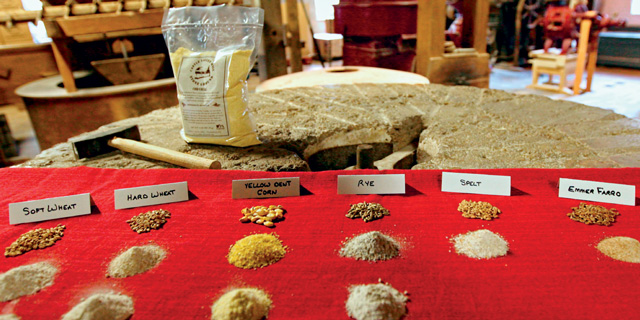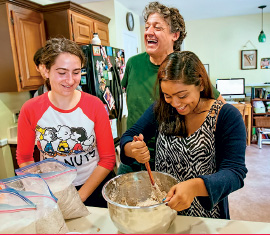True Grits

By Sharon Sanders | PHOTOGRAPHY BY CHUCK ZOVKO
Mark Fischer ’87 walks along the Neshaminy Creek, heading for a gristmill perched on its banks. He steps into an impressive and imposing stone-and-timber structure that has defined this spot on the creek since its construction in 1730. The air inside the mill is still and silent. The centuries-old machinery is both strange and oddly familiar, as if Willy Wonka showed up to redecorate Ron Weasley’s family home.
Fischer starts up the mill, and suddenly the atmosphere comes alive in a mad burst of sights and sounds. The badoop-badoop of whirring belts competes with the tacka-tacka of little wooden doors that spill open and slap closed. Grain-filled bucket elevators lead to a hopper, one that feeds the beast itself—a 3,000-pound French buhr grinding stone from Alsace.
“It’s freshwater quartz as hard as diamonds,” says Mark. “It was the Cadillac of stones back in the day.”
The quartz’s day seems to have come back.

TO GO FORWARD, STEP BACK
In 2011, Mark and his wife, Fran Henry ’87 Fischer, were at a crossroads. Mark, an electrical engineering graduate, had just accepted a buyout from his aviation industry employer that included a non-compete clause.
Fran, an English and psychology with a concentration in women’s and gender studies graduate, had worked in the commodities and securities industry before parenting and home-schooling their children. She and Mark had long talked about going into business together.
The answer, it turned out, was sitting outside their window.
“We make good food the way God meant it to be.”
–Mark Fischer ’87
The Fischers and their children—Deming, 20; Curran, 18; and Liesel, 16—live on the Bucks County, Pa, property, where the mill is located. The land was purchased in 1947 by Henry Fischer—Mark’s grandfather—after he emigrated to the United States from Bavaria, a state in southeastern Germany. And on that property stood an abandoned mill.
Although he had been a miller in Bavaria, Henry Fischer saw the increasing pressure on small operations from larger corporations and never restarted the mill. Instead, he was content to pursue another career in a moving company and focus on raising a family.
But Henry didn’t abandon milling altogether; he filled the old building to the rafters with a collection of salvaged antique equipment from other area mills that had shut down in the face of large-scale operations. As he did so, he inadvertently created a playground for the fertile imagination of his grandson.
After his buyout, Mark looked out on that mill every morning and thought of its cache of antique equipment, remembering the many happy days he had spent exploring it, both before and after he bought the 20-acre family plot.

“It was like a Pandora’s box. Mark couldn’t resist it,” Fran says. Five years ago, they started the long process of reopening Castle Valley Mill as an operational mill. Both Mark and Curran became certified millers through the Society for the Preservation of Old Mills. They needed that expertise and training to use their historic equipment. “Almost all of the mid-19th century equipment we use now was already here,” says Mark.
The basic grinding technology has remained unchanged for 5,000 years. One stone stands still while the other turns. The miller adjusts the space between the stones and the speed at which they turn (up to 100 rpm) to give the desired grind.
There’s also a “newer” technology used in three-story mills like Castle Valley Mill. Dated to the late 1790s, it follows the design of the brilliant inventor Oliver Evans who modernized the previously laborious and questionably sanitary process of moving and grinding grains.

Evans’ design allows grains to be dumped into a chute in the floor then transported vertically and laterally between three stories by a run of narrow wooden elevators. It saves a significant amount of labor.
“We run this mill with two people,” says Mark. Of course, each person has more than one job. Besides being a miller, Mark is a woodworker, metallurgist, mechanic, and—most recently—historical researcher, as he tracks down technical documents from Evans and other notable millers.
Fran handles the management, marketing, and order fulfillment for the business. Products are sold through distributors and local retailers. “We have to use every tool in our tool kit,” she says. “We do not get bored.”

TO GO BACK, STEP FORWARD
The Fischers love being surrounded by the history of Castle Valley Mill. “We are doing something we completely believe in,” says Fran. “We fall in bed at night exhausted.”
One of the most fascinating aspects of history, they found, is that it can support and inform the life of today. The grains they mill and the techniques they use to mill them are rooted in sound historical practice.
The grains themselves sound as if they come straight from a medieval marketplace: emmer farro, spelt, Redeemer wheat, Bloody Butcher corn, Yellow Dent corn, and other ancient and heirloom strains of grains. All are grown by small-scale farmers within a 100-mile radius of the mill.
“We make good food the way God meant it to be,” says Mark. All the essential and highly nutritious parts of the grain—the outside bran, the perishable part called the germ, and the starchy endosperm—are crushed under cool conditions that keep the nutrients intact.
And people notice.

“The biggest difference between Castle Valley products and mass-produced flours or grains is the freshness,” says Nina Subhas, head baker at Roberta’s Pizza in Brooklyn, whose creations include toasted rye boule and a sprouted purple barley and emmer batard.
Bon Appétit magazine calls the bread and bagels at Philadelphia’s High Street on Market “some of the country’s best.” The restaurant’s baker, Alex Bois, gets his stone-ground grains from Castle Valley Mill. At Lafayette, executive chef John Soder uses Castle Valley Mill hard whole-wheat flour for pizza dough and soft whole wheat for pancakes. He plans to incorporate grits and grains into dining service menus soon.
Other customers include The Bayou in Bethlehem, Grain in Allentown, Vetri Ristorante in Philadelphia, Beuchert’s Saloon in Washington, D.C., and the Facebook corporate dining room in New York City.
What started as a modest marketing effort using a mailing list and postcards soon spread through the East Coast locavore community by word of mouth. “When you deal with true artists and chefs, they tell their friends,” Fran says.
From Mill to Gil
Take 30 Pounds of Castle Valley Mill Flour. Put It Into the Hands of an Art Professor. Bread Becomes a Masterpiece.
Nestor Armando Gil happily clangs and clanks his cast-iron pans. It’s not the din tickling his fancy, though; it’s the flour arrayed in front of him in his home on College Hill. There’s spelt, emmer, rye, Warthog hard wheat, and soft red winter wheat, all stone ground and freshly delivered from Castle Valley Mill.

“It’s amazing, amazing flour. It’s just crazy what it does and how it behaves and feels between your fingers. Its hydration, how it tastes—it’s a whole different thing.
The Fischers talk about it as being alive, and I love that.”
Gil has long known that flour, and the bread it makes, really is a living food. As an assistant professor of art, he teaches a first-year seminar titled Bread, in which 16 students learn to imbue life into the lifeless by cultivating yeasts taken from the very air surrounding them. Through the filters of poetry, magic, metaphor, technology, industry, and art, Gil also uses bread as a vehicle to practice critical college-level reading and writing skills.
On the second day of class, his students take chopsticks and mix flour and water in a Mason jar. They then leave with their pots of primordial soup and set them, uncovered, in the middle of rich terrestrial biomes known as dorm rooms. Wild yeasts settle into the mixtures, turning them into sourdough starter, a teaspoon of which contains 5 billion beneficial bacteria in 50 million yeast cells. This starter dough will eventually make its way to Gil’s kitchen, and his students will turn it into piping hot sourdough loaves.
Today, however, it’s Gil’s turn to bake. He pours one of the Castle Valley flours into a bowl, then stops. It seems as if he is looking at it intently, but he’s not—he’s listening to it intently. “This flour is going to ask me to bake it differently,” he says.
Grains milled on industrial-scale, high-speed, high-heat rollers produce flour that, to Gil, speak with a shout—effective but crude. Alternately, grains ground on stones in small batches by individual millers produce flours with many interesting voices.
To demonstrate, he holds out a handful of Castle Valley Mill flour. “It’s kind of greasy, right?” Then he does the same with a handful of heavily refined commercial flour. “It’s super soft but dry.”
Soft and dry is fine if you want to make baby powder, but if it’s truly divine bread you’re after, you want to know the natural oils are still in the flour. Those oils, along with the germ and bran, hold almost all the complex nutrition and rich flavors of the plant.
Gil dips a wooden spoon into the bowl, stirs gently, and stands back. “Now we can leave it there for about half an hour before I mess with it again.”
The next 30 minutes is called the autolyse period. It’s a resting spot between mixing and kneading the dough that lets the yeast start to work on breaking down the starches into more tender and toothsome structures.
“The yeast is like ta-da, yeah, go, go, go, and it makes big, beautiful elastic holes,” he says. “I didn’t invent any of this. It’s something I learned not long ago. A half-hour and then salt. And that half-hour means something. There are billions of creatures in there doing my job for me.”
The job isn’t entirely finished off by his microscopic minions, of course. Gil ends the autolyse period with the aforementioned salt, kneads and forms the dough with enough care that any midwife would nod approvingly, and pops pan after pan into a high-heat oven.
The scent of baking bread is satisfying enough. But then it’s out of the oven and, after another 30 minutes, in slices. Gil hands me one, its thick meaty crust still warm. There are hints of sweetness, molasses maybe. “Barley malt,” Gil says. “How can you ever go back to Wonder Bread?” I ask. Gil nods and swallows.
—Kathleen Parrish